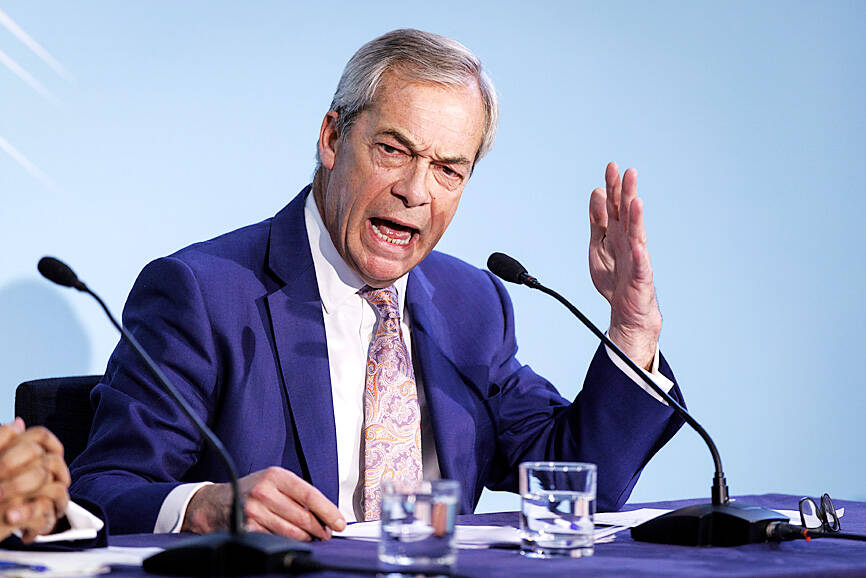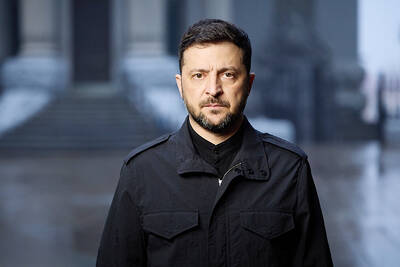Plans for a new UK digital ID are sparking widespread public concern, but some critics including far-right politicians are fueling fears with unproven claims that it would be used to boost government control over people’s lives.
They warn that the digital ID would be used to store data on vaccinations and carbon footprint, and limit access to flying and food, which the government has vehemently denied.
British Prime Minister Keir Starmer in September said that the ID card would be introduced by 2029. The government has said it would not be mandatory, but would be required to prove the right to work.

Photo: EPA
Nigel Farage, the leader of anti-immigration party Reform, claimed on TV channel GB News that medical data would soon be added and those unvaccinated would be treated as “second-class citizens.”
“Step out of line, say something they don’t like and they will switch you off: no travel, no car, no spending, no life,” said Renee Hoenderkamp, a doctor and commentator on GB News, a right-wing television channel.
“None of these claims have any factual basis. We have been clear: digital ID will not be compulsory and it will not be a crime not to have one,” a British government spokesperson said.
“Digital ID will give people more control over how their data is used and ensure everyone can access the public services they need,” the government spokesperson said.
The plan is highly controversial in the UK — where the idea of an ID has long been resisted — and the main opposition parties are against it.
Public support for digital ID fell after Starmer’s announcement.
Think tank More in Common in late September found that 45 percent opposed it and 31 percent backed it, down from 53 percent support late last year.
Nearly 3 million people have signed a petition against the plan, triggering a debate in parliament’s Westminster Hall on Dec. 8.
“It is certainly not a fringe issue. This is a mainstream political issue with concerns shared by people in the highest echelons of politics,” said Silkie Carlo, director of the Big Brother Watch advocacy group, who addressed lawmakers about civil liberty fears.
Ryan Wain, executive director of politics and policy at the Tony Blair Institute think tank, said that the British government needs to “make a broader case” for the digital ID, which Blair has long backed.
“Otherwise, a vacuum is left”, Wain said, adding that this is filled by people “whose default is to think the worst of the best intentions.”
TikTok creators have posted artificial intelligence-generated videos of huge demonstrations against the digital ID in central London, racking up millions of views, although actual street protests have been relatively small.
Some opponents previously campaigned against public health restrictions and linked the digital ID to those measures.
A popular post showed an image of Chinese kindergarten pupils lined up with QR codes to take COVID-19 tests in 2022, with the caption: “What happens when you say no?”
David Icke, a prominent British conspiracy theorist who dismissed COVID-19 as a “hoax,” took part in a march against the digital ID in London last month.
Hundreds participated in the march whose organizer, law student Fiona Hine, was previously arrested at anti-lockdown demonstrations.
“This is entirely about freedom and freedom of choice — nothing should be imposed on us,” Hine said.
The digital ID was a topic during past anti-lockdown rallies, with protesters “talking about how it will be like China” and a “sign of an authoritarian state,” said Ozge Ozduzen, a lecturer in digital media at Sheffield University.
Repeating popular conspiratorial tropes, Hine claimed that the digital ID is being planned by an international “elite” — including Blair and Klaus Schwab, the founder of the World Economic Forum — who want people to be “robots and worker bees for the government.”

DISASTER: The Bangladesh Meteorological Department recorded a magnitude 5.7 and tremors reached as far as Kolkata, India, more than 300km away from the epicenter A powerful earthquake struck Bangladesh yesterday outside the crowded capital, Dhaka, killing at least five people and injuring about a hundred, the government said. The magnitude 5.5 quake struck at 10:38am near Narsingdi, Bangladesh, about 33km from Dhaka, the US Geological Survey (USGS) said. The earthquake sparked fear and chaos with many in the Muslim-majority nation of 170 million people at home on their day off. AFP reporters in Dhaka said they saw people weeping in the streets while others appeared shocked. Bangladesh Interim Leader Muhammad Yunus expressed his “deep shock and sorrow over the news of casualties in various districts.” At least five people,

It is one of the world’s most famous unsolved codes whose answer could sell for a fortune — but two US friends say they have already found the secret hidden by Kryptos. The S-shaped copper sculpture has baffled cryptography enthusiasts since its 1990 installation on the grounds of the CIA headquarters in Virginia, with three of its four messages deciphered so far. Yet K4, the final passage, has kept codebreakers scratching their heads. Sculptor Jim Sanborn, 80, has been so overwhelmed by guesses that he started charging US$50 for each response. Sanborn in August announced he would auction the 97-character solution to K4

SHOW OF FORCE: The US has held nine multilateral drills near Guam in the past four months, which Australia said was important to deter coercion in the region Five Chinese research vessels, including ships used for space and missile tracking and underwater mapping, were active in the northwest Pacific last month, as the US stepped up military exercises, data compiled by a Guam-based group shows. Rapid militarization in the northern Pacific gets insufficient attention, the Pacific Center for Island Security said, adding that it makes island populations a potential target in any great-power conflict. “If you look at the number of US and bilateral and multilateral exercises, there is a lot of activity,” Leland Bettis, the director of the group that seeks to flag regional security risks, said in an

‘DIGNITY’: The Ukrainian president said that ‘we did not not betray Ukraine then, we will not do so now,’ amid US pressure to give significant concessions to Russia Ukrainian President Volodymyr Zelenskiy on Friday pushed back against a US plan to end the war in Ukraine, while Russian President Vladimir Putin welcomed the proposal that includes many of his hardline demands. With US President Donald Trump giving Ukraine less than a week to sign, Zelenskiy pledged to work to ensure any deal would not “betray” Ukraine’s interests, while acknowledging he risked losing Washington as an ally. Putin said the blueprint could “lay the foundation” for a final peace settlement, but threatened more land seizures if Ukraine walked away from negotiations. Ukraine faces one of the most challenging moments in its history,